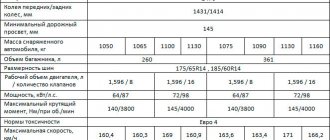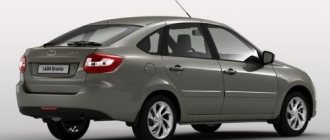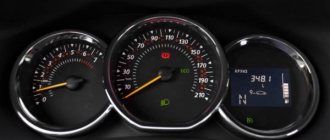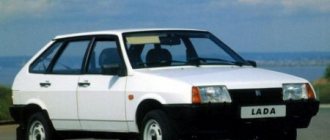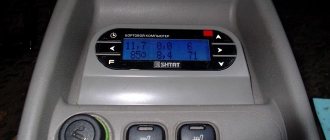Factory standard fuel consumption indicators for Lada Kalina
There are four main models of the Lada Kalina passenger car:
- sedan - has a closed body, with 2-3 rows of seats for the driver and passengers, the trunk is separated from the car interior, there is no lifting door in the rear wall;
- station wagon - has a closed cargo-passenger body, one of the sedan variants, which has an enlarged luggage compartment, is equipped with a lifting door in the rear wall;
- hatchback - has a body with 1-2 rows of driver and passenger seats, with a shortened rear overhang (hence the name - “hatchback” means “short”) and a smaller luggage compartment, equipped with a lift-up door in the rear wall;
- sport - is a sports version, which is equipped with a number of special parts - a bumper, an exhaust pipe tip, sports pedals, alloy wheels, a SAAZ Sport sports suspension, front and rear disc brakes, an original reinforced gearbox.
As you can see, the main difference between each model is its body type. Gasoline consumption (unleaded AI-95) is calculated in liters over a driving cycle, which is 100 kilometers.
In this case, the following parameters of the vehicle itself are taken into account:
- Engine size (Lada Kalina comes in two types - 1.4 l and 1.6 l).
- Number of valves (for Lada Kalina - 8 and 16).
Experts have prepared an information table that shows the factory fuel consumption indicators for each model of the Lada Kalina passenger car, taking into account the mandatory parameters.
| Model Lada Kalina | 1.6 l (8 valves) | 1.6 l (16 valves) | 1.4 l (16 valves) |
| sedan | 7,8 | 7,2 | 7,0 |
| station wagon | 7,3 | 7,2 | 7,0 |
| hatchback | 7,3 | 7,3 | 7,0 |
| sport | – | 7,8 | – |
The manufacturer sets the standards for digital fuel consumption indicators for each Lada Kalina model based on the results of test runs of passenger cars on a special track. But on the track, driving conditions are reduced to ideal, and the car is driven by an experienced driver. In real conditions, everything becomes much more complicated. In addition, the speed indicator during real driving is not always within the required limits - from 100 km/h to 120 km/h. This is due to the fact that some drivers do not recognize the established framework for optimal driving of a Lada Kalina car, which significantly affects fuel costs.
Real fuel consumption of Lada Kalina (according to reviews from car owners)
Many car owners of the Lada Kalina passenger car complain that in reality, gasoline consumption indicators differ from those specified by the manufacturer. For comparison, let’s look at another information table prepared by specialists taking into account feedback from Lada Kalina car owners.
| Terrain type | Lada Kalina, 1.4 l | Lada Kalina, 1.6 l | ||
| Fuel consumption (l/100 km) | Average (l/100 km) | Fuel consumption (l/100 km) | Average (l/100 km) | |
| Urban | 6,8-11,5 | 8,47 | 7,0-12 | 9,5 |
| Route | 5,0-8,5 | 6,18 | 5,6-9 | 6,8 |
| Mixed | 6,5-8,3 | 7,29 | 7,0-9,0 | 8,0 |
When comparing two information tables, it is clear that the real figures are indeed higher than the stated factory fuel consumption standards for the Lada Kalina. What are the reasons for this discrepancy between the figures?
The main reasons for the difference between the gas consumption figures for the Lada Kalina passenger car - real and factory ones
There are several reasons for the discrepancy between the actual gasoline consumption figures of the Lada Kalina and the factory standards. Experienced car enthusiasts identify typical ones among them:
- Type of terrain - driving in the city, on the highway, off-road or mixed type of road (the more complex the type of road, the higher the fuel consumption).
- The driver's driving style is slow driving, fast driving, with sharp acceleration, with sharp braking (the more complex the driving style, the higher the gas consumption).
- The quality of the fuel used - AI-95 gasoline is consumed less than AI-92 gasoline.
- Time of year - in winter, fuel consumption rates will be higher, this is affected by icing of the road surface and frequent warming up of the vehicle itself.
- Traffic jams - due to slow driving and frequent braking, gasoline consumption increases by almost several liters.
- Using additional car devices (for example, air conditioning) – with devices constantly on, gasoline consumption will be 0.5-1 liter more.
In addition to the reasons listed, fuel consumption can be affected by various breakdowns of the vehicle itself:
- incorrect readings of the electronic engine control system due to sensor errors - temperature, mass air flow, oxygen, throttle position;
- abnormal pressure in the fuel system;
- internal combustion engine injector malfunction;
- failure of the catalyst;
- dirty air filter.
To install them, the car owner needs to diagnose the Lada Kalina passenger car. After diagnosing and identifying the causes of malfunctions, the vehicle is repaired.
Source
Fuel consumption per 100 km Lada Kalina 2 16V. Reviews © Engine capacity 16
| Kalina's gasoline consumption increased by 8 liters, after running it began to burn, now the sensor shows 14.9 liters per 100 km, maybe there is a problem in the electronics, or it is necessary to reflash the engine in the home, although many on the forum say that this will not help. Only in 2007, the automobile concern rolled out the Lada Kalina with a station wagon 1117; its fuel consumption parameters are approximately the same as those of cars in other bodies, except that when driving in urban areas it consumes 200-300 grams. |
| Fuel consumption Lada Kalina Time of year in winter, fuel consumption rates will be higher, this is affected by icing of the road surface and frequent warming up of the vehicle itself. If the TPS is initially set incorrectly, then the naive and trusting computer equipment will accept the distorted readings as the only correct ones. |
- gasoline quality;
- technical condition of the engine and transmission;
- driving style;
- terms of Use;
- tire pressure;
Lada Kalina - engine type and size • You just need to try to avoid unnecessary overtaking with the gas pedal pressed to the floor, and also, as mentioned above, try to slow down with the engine.
How much gasoline does Lada Kalina consume - passport and real data
In November 2004, the first series of the Lada Kalina people's car came off the assembly line of the AvtoVAZ concern. According to some reports, the first samples of small-scale production appeared on the market back in 1998. When production was established, the car began to be equipped in three body types: a 5-door hatchback and a sedan, and later a station wagon. The manufacturer's data indicates that the fuel consumption of the Lada Kalina is at an average level, which is confirmed by numerous reviews from owners. Subsequently, both the body and the power unit of this car were modernized, and today the second series of LADA Kalina is being produced.
Official data on gasoline consumption
There are two series of cars and several more of their modifications; data on gasoline consumption of the Lada Kalina differ somewhat, depending on the installed engine and body type. Typically, a station wagon consumes more gas than a hatchback or sedan due to the vehicle's greater weight. However, according to the manufacturer, there may be a slight difference in consumption even between a hatchback and a sedan of the same series, modification and year of manufacture.
In theory, the Lada Kalina has an average gasoline consumption for a 1.4 liter engine of about 9.6 liters. in the city and up to 6.3 l. when driving on an open road. Naturally, each modification has its own characteristics, parameters and technical characteristics; we will consider below exactly how this affects the fuel consumption of the Lada Kalina.
Lada Kalina 1.4, 1.6 fuel consumption per 100 km. 1st, 2nd generation
I have owned a Lada Kalina (VAZ-1117, station wagon, volume 1.4 liters, 16 valves) for 1.5 years. During this time I drove more than 20,000 km. Therefore, I have already formed a certain opinion about Kalina, which I want to share.
I’ll say right away that, in my deep conviction, Kalina is the best car produced by AvtoVAZ in the first decade of the current century. Previously, I had experience in operating VAZ 2101, 2103, 2106, 2107, 2109.
The car was purchased second hand in 2012. Lada Kalina, 2009, mid-spec (ABS, air conditioning), station wagon, 1.4 liter engine, 16 valves. At the time of purchase, the mileage was almost 60,000 km. The review will concern this specific configuration. At the time of writing (February 2014), the car had covered 80,000 km.
First generation
The first sedan car went on sale in 2004; the car was equipped with a 1.4 liter engine with 89 horsepower. Fuel consumption of Lada Kalina 1118 (factory designation) had the following values:
- City - 9.6 l. per 100 km.
- Route – 6.3 l. per 100 km.
- Mixed pace - 7.8 l. per 100 km.
It should be noted that in 2009 the production of the first generation of LADA Kalina sedans was suspended, but within a few months the cycle was established, and until 2011 this model was produced by the AvtoVAZ concern.
Hatchbacks went on sale a little later, towards the end of 2006, and then production of the Lada Kalina (1119) was launched. These cars, as well as sedans, began to be equipped with a more powerful engine, which had a 1.6 liter fuel compartment and was produced with a power of 81 hp and 98 hp. According to the requests of the factory developers, which corresponded to the reviews of the owners, the car with an 81-horsepower engine had the following fuel consumption indicators per hundred kilometers:
- City - 10.2 l.
- Route – 6.6 l.
- Mixed temp – 7.4 l.
As for the 98 horsepower engine, the consumption per hundred kilometers of road under different conditions is:
- City - 9.7 l.
- Route – 6.4 l.
- Mixed temp – 7.1 l.
Only in 2007, the automobile concern rolled out the Lada Kalina with a station wagon (1117), its fuel consumption parameters are approximately the same as those of cars in other bodies, except that when driving in the city it consumes 200-300 grams. more gasoline.
One of the branches produced in limited series was the LADA Kalina Sport (11196), this car was released in 2008. Her gasoline consumption figures per 100 km are:
- City - 9.4 l.
- Route – 6.7 l.
- Mixed pace - 8.9 l.
Like the entire first series, LADA Kalina Sport ceased production in mid-2013.
Real data, according to owner reviews
- Victor, Saratov. I've been driving this car for a long time, everything has happened, except serious accidents, and I've gotten to know the car well. There are weaknesses in the body; the front arches began to rot especially quickly. But the engine is reliable, provided of course you use high-quality gasoline, oil and coolant. Lada Kalina with a 1.4 liter 16-valve engine has average fuel consumption. I drive mostly around the city and, as before, I pour ten liters per hundred kilometers in heavy traffic.
- Sergey, St. Petersburg. I bought a Kalina hatchback for maneuverable driving around the city while working. In 2010, I made a choice in favor of the 1.6 liter 16 valve version, and I think it was right. The car is really nimble, and the fuel consumption on this Kalina is even lower than on its less powerful brothers in the shop. Of course, very often you have to get stuck in traffic jams, so the figure of 11 liters per 100 km does not seem significant.
- Stepan, Ufa. I bought a good station wagon from the domestic auto industry first-hand in 2013; at that time the car was in good condition, although the struts were already knocking. During operation, everything else began to crumble, including the engine. The workshop said that I often filled with low-quality fuel, this seems to be true, the gas station near my house does not belong to any of the well-known networks. Kalina's consumption per 100 km is approximately 11-12 liters in the city, but on the highway maybe a little less, I didn't measure it.
- Yaroslav, Kazan. I live on the outskirts of the city and my work is shift work, so I can avoid major traffic jams and get to my destination with minimal fuel loss. Therefore, my sedan’s fuel consumption per hundred kilometers is slightly less than 9 liters. Otherwise, I am also completely satisfied with the Lada Kalina; she feels confident both off-road and on high-speed sections of the highway.
- Alexander, Konstantinovka. Buying a 1.6 liter Lada Kalina. and 8 valves, was not the best investment. I was guided then by the advice of my comrades, they say, this motor is the most reliable. In fact, the breakdowns were not long in coming, although they were minor, but I think others fail just as often. But the gasoline consumption of a car with such an engine is the highest; it simply does not have enough power to gain speed confidently. So it turns out that even on the highway she eats at least 9 liters per hundred square meters.
conclusions
The first generation Kalina cars were equipped with the most common 8-valve petrol engine with a displacement of 1.6 liters. This unit was assigned the number 11183.
Vyacheslav1502
offline puki4 Regular chaser
Registration: 08/21/2016 Messages: 19 Address: St. Petersburg #3 puki4, 08/21/2016 22:09 we looked at the pump, it seems to be pumping normally, as the mechanic said. offline Stil Pro Diagnostic-electrician, mechanic
Registration: 04/01/2009 Messages: 8,935 Address: Russia, Krasnodar region village. Great #4 Stil, 08/21/2016 22:11 Message from puki4 : ^ seems to be pumping normally Click to expand. How much is this? offline Gudvin Veteran Auto Repair
Registration: 12/20/2009 Messages: 769 Address: Smolensk region. Desnogorsk #5 Gudvin, 08/21/2016 23:10 Message from puki4 : ^
Greetings ! Tell me about the problem, in general I bought a viburnum, there was a jamb with the receipt, I read the errors myself through elm327, the camshaft sensor and the detonation sensor showed an error, I replaced everything, there are no errors. In general, the owner said that the catalyst was cut out, when asked whether the car was flashed, he said “no”, but the check does not light up, the car is Euro 2, 1 oxygen sensor, they said it was working, in general it shows the consumption according to the on-board computer is 18 l/100 km, as be ? We cleaned the injectors, replaced the high voltage wires and spark plugs. We connected the computer, it shows 1.1 liters per hour at idle. When driving, it shows 11-13 liters of instantaneous consumption on the side of the viburnum, but also somehow intermittently, sometimes 6-7, sometimes 15, I don’t drive, it’s the 1st car. The car (Kalina 2006), the firmware seems to be the original I201CP57. The fuel is really running out ((
Click to expand.
I think you should go for a diagnosis. Otherwise, everything will work out for you, “it seems.” don’t trust the bortovik, this is a toy for car enthusiasts
Second generation
Since 2013, the Lada Kalina car line has been updated and new cars have entered the market. Among them was not the usual sedan, with which the series began production, but the production of 5-door hatchbacks and station wagons continued. Fuel consumption on the new Lada Kalina has been reduced, but the manufacturer's requests do not always correspond to customer reviews.
The second Kalina came with two types of engines, each with a volume of 1.6 liters, but their power differed. There was also a choice of transmission options; as before, it was possible to purchase a car with a manual 5-speed gearbox or with a 4-speed automatic. A new feature was the entry into the arena of a 5-speed robotic transmission.
The power units installed on the Lada Kalina 2 had the following fuel consumption:
- VAZ-21126 - 98-horsepower engine, 1.6 liter capacity. with four cylinders and 16 valves, it was equipped with a distributed fuel injection system. Gasoline consumption figures in the city are 9.9 liters, on the highway 6.5 liters.
- VAZ-21127 - had 106 hp at its disposal. And fuel consumption on a free road was 5.8 liters, in urban driving it was 8.4 liters. Gasoline was also supplied by distributed injection.
Owners about consumption on Kalina 2
- Peter, Tyumen. I bought a Lada Kalina Cross in 2015. This is one of the few representatives of the domestic automobile industry with horsepower exceeding one hundred. And indeed the car turned out to be lively; my hatchback can compete with some foreign cars when driving on open sections of the road. The other side of the coin is gasoline consumption in the city; I did not observe the promised 8.4 liters both during the run-in and after it. This engine consumes at least 10 liters per 100 km of road with traffic jams.
- Lev, Voronezh. My wife does not know how to use a manual transmission, so I had to buy a car with an automatic transmission system. The choice fell on the second generation Lada Kalina 2014. Naturally, I understood that, as with any automatic, fuel consumption would be higher than with a manual, and that’s what happened. My figures in the city, judging by the on-board computer data, are usually within the range of 11-12.5 liters per 100 km of traffic. This sad moment worsened three years after the purchase, the injector with nozzles became clogged, for some reason this happens more often on the 8-valve Kalina than on other engines.
- Taras. Moscow. I never regretted buying Kalina Cross for my baby; she often helped me out in situations when more expensive foreign cars failed. And when breakdowns happened, and this happens, the repairs did not cost me much at all. Of course, it cannot be considered a plus that the Lada Kalina has fuel consumption per 100 km, with a power of 106 hp. higher than foreign cars of the same class. In my case, in the city, I fill at the rate of 12 liters, but on the highway the situation changes dramatically and costs drop to 7.5 liters.
- Ilya, Odessa. For a car with such a price, many disadvantages are forgiven, but they exist. First of all, this is the fuel consumption of the Kalina; it can sometimes be compared with the performance of some SUVs. Regular failure of components and parts is also somewhat annoying, but the main thing for me is road noise. Compared to foreign cars, you feel as if you are driving without doors. Of course, there are also advantages: it is inexpensive to service and parts are always easily accessible.
- Andrey, Nakhabino. I don’t understand why people have so much hatred for the Lada Kalina, because you can find out everything about it before buying, and there are plenty of disadvantages, but there are also advantages. Mostly they complain about high gasoline consumption, but you can always install LPG and save money. The metal on the body is good and thick, its quality cannot be compared with Chinese tins. It’s just a pity that the quality of the factory paint is rather weak, and over the years bubbles appear in some places.
Owners about consumption on Kalina 2 Engine 11194 characteristics
| What is the real fuel consumption of Lada Kalina 2nd generation - RepontoMore However, after a detailed and lengthy discussion of the problem, many car enthusiasts agree that increased fuel consumption is a subjective concept and depends on many factors. The car shakes a lot when I’m standing at an intersection, the revs range from 500-1000, it smells of gasoline, there’s a slight black smoke, increased fuel consumption, black spark plugs, etc. |
| Fuel consumption per 100 km Lada: Granta, Largus, Kalina, Priora, Vesta In order not to go far for an example, I will share observations about the fuel consumption of my car Lada Kalina with a 1.6-liter VAZ-11183 8-valve engine and a manual gearbox. There are several possible reasons for such lies: the engine coolant temperature sensor is faulty; The thermostat is faulty; The cooling system is air-locked; an air lock has occurred somewhere; radiator is faulty; computer crash. |
- If the timing belt breaks, the valves bend.
Review • the fact that the gear lever starts to creak after a few months of use.
Reasons for high fuel consumption
It is believed that Kalina’s consumption of gasoline, high fuel consumption, has objective reasons, but this is not always the case. There are situations in which the owner himself is to blame for increased fuel costs, among them:
- Aggressive driving style - unreasonable acceleration on busy sections of the road, leads to increased costs, driving on the highway at the maximum speed for a car also causes unnecessary losses. On an open road, you should not exceed the cruising speed of 90-110 km/h.
- Untimely maintenance - failure or clogging of some components responsible for supplying gasoline to the combustion chamber leads to increased consumption. Wear of the piston system, like
- Viburnum, like other car brands, is also a common cause of high fuel costs. Poor quality fuel - you should not trust unverified gas stations, especially if they do not have known identification marks.
Based on the information provided, we can conclude that the Lada Kalina, like any other car, has a number of disadvantages, but it also has advantages, so you should weigh the pros and cons before purchasing.
Source
VAZ 21126 (1.6-16cl): • Lada Kalina
| Lada Kalina fuel consumption per 100 km - Auto repair shop online But all the same, on the highway, if you need to abandon the truck and accelerate sharply from a speed of 90 km/h, then engaging fourth or even third gear does not really solve the problem. The engine is quite dynamic, but performs better at high speeds, which affects its fuel economy; it is not inferior to its 1. |
Lada Xray • Kalina-2 is confidently conquering its market segment not only in Russia, but also in other countries.

